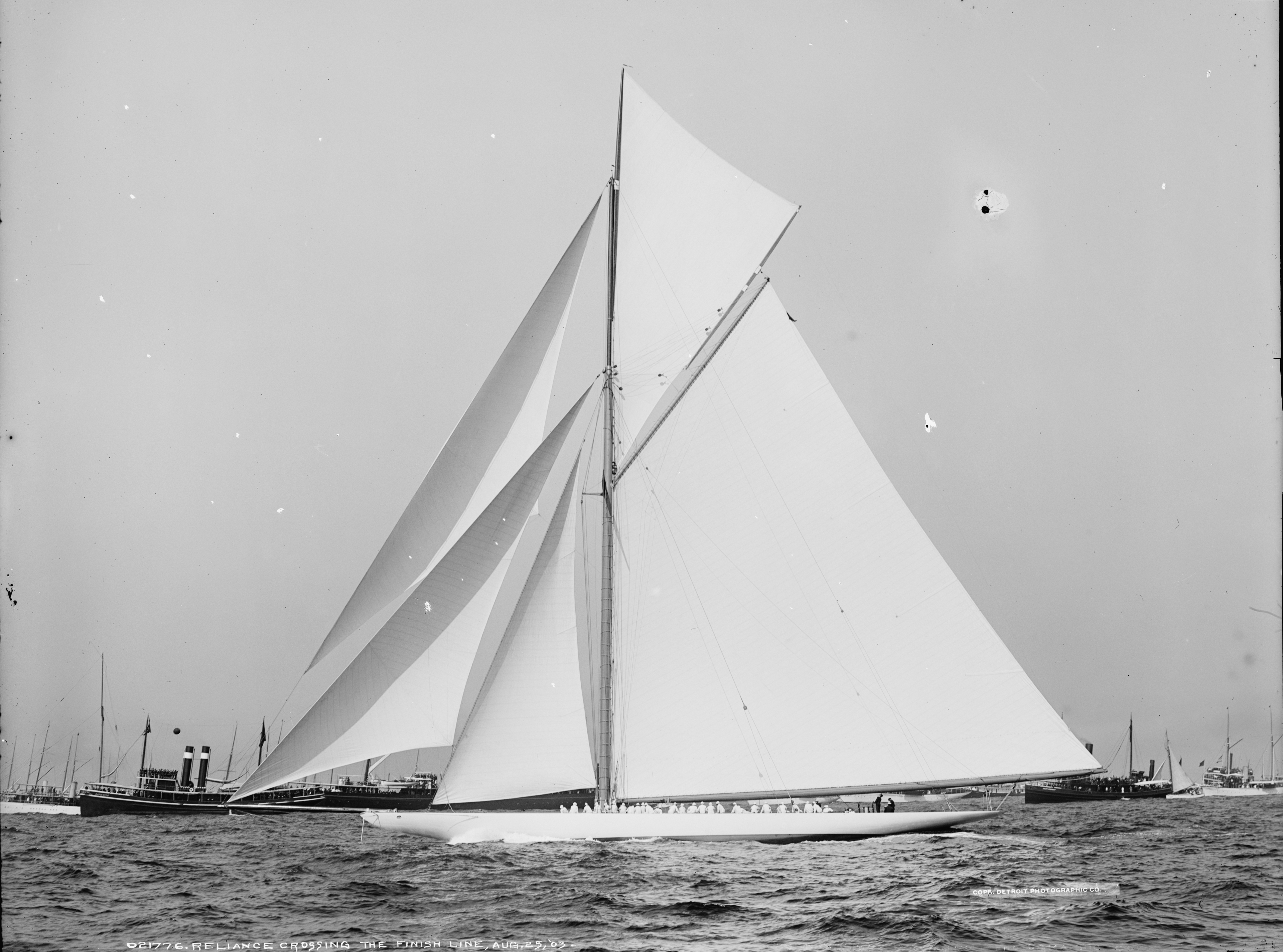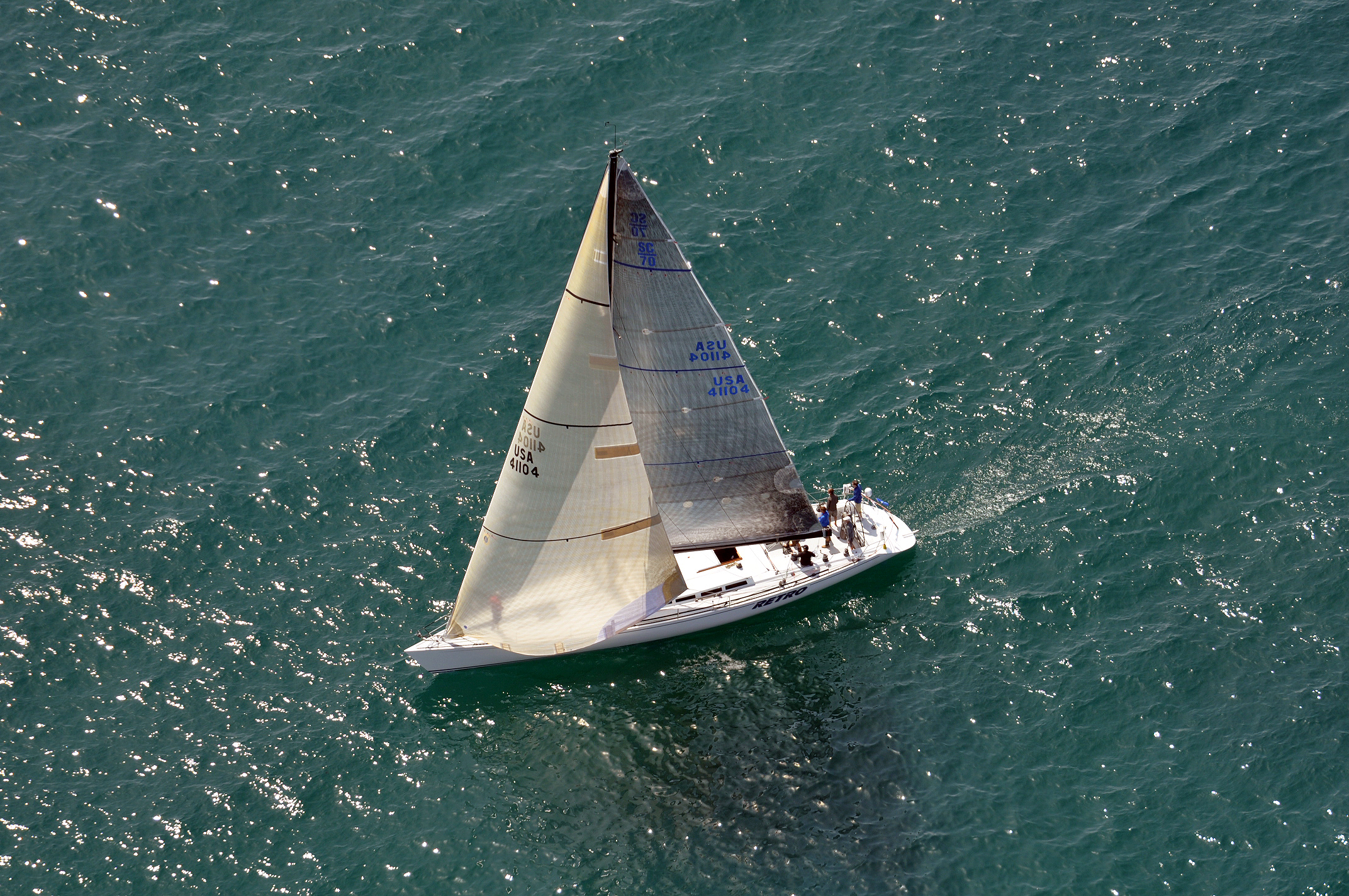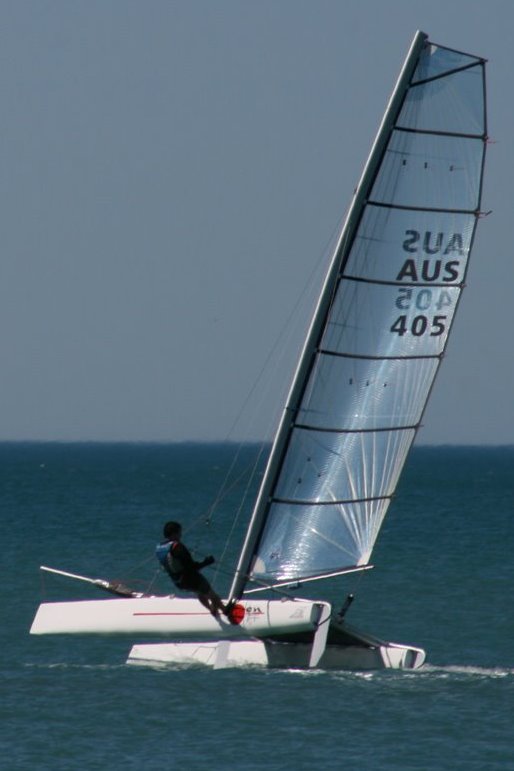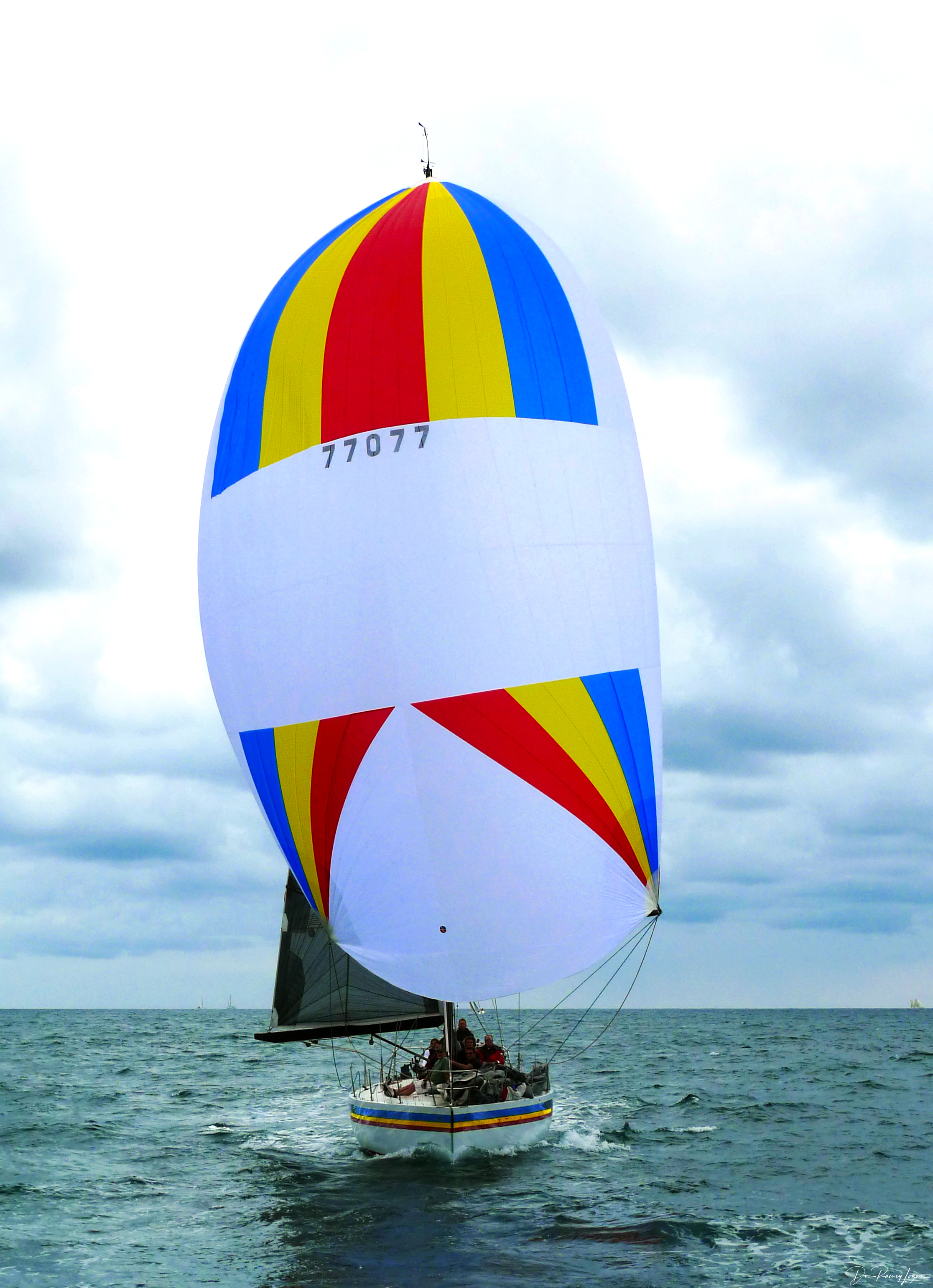|
Mainsail
A mainsail is a sail rigged on the main mast (sailing), mast of a sailing vessel. * On a square rigged vessel, it is the lowest and largest sail on the main mast. * On a fore-and-aft rigged vessel, it is the sail rigged aft of the main mast. The sail's foot is normally attached to a Boom (sailing), boom. (In extremely heavy weather, the mainsail may be lowered, and a much smaller trysail hoisted in its place). Historical fore-and-aft rigs used a four-sided gaff rigged mainsail, sometimes setting a gaff topsail above it. Whereas once the mainsail was typically the largest sail, today the mainsail may be smaller than the jib or genoa; G. Prout & Sons, Prout Catamaran#History, catamarans typically have a Mast-aft rig, mainmast stepped further aft than in a standard sloop, so that the mainsail is much smaller than the foresail. Bermuda rig The modern Bermuda rig uses a triangular mainsail aft of the mast, closely coordinated with a jib for sailing upwind. A large overlapping ... [...More Info...] [...Related Items...] OR: [Wikipedia] [Google] [Baidu] |
Mast-aft Rig
A mast-aft rig is a sailboat rig that uses a single mast set in the aft half of the hull. The mast supports a sail plan that may consist of a single jib, multiple staysails, or a crab claw sail. The mainsail is either small or completely absent. Mast-aft rigs are uncommon, but are found on a few custom, and production sailboats. Comparison to other single mast rigs Many mast-aft rigs utilize a small mainsail and multiple staysails that can resemble some cutter rigs. A cutter is a single masted vessel, differentiated from a sloop either by the number of staysails, with a sloop having one and a cutter more than one, or by the position of the mast, with a cutter's mast being located between 50% and 70% of the way from the aft to the front of the sailplan, and a sloop's mast being located forward of the 70% mark. A mast-aft rig could, based on headsail count, be considered a variation of the sloop or cutter, or, based on mast position, a unique rig. Advantages In the typical ... [...More Info...] [...Related Items...] OR: [Wikipedia] [Google] [Baidu] |
Sailing
Sailing employs the wind—acting on sails, wingsails or kites—to propel a craft on the surface of the ''water'' (sailing ship, sailboat, raft, Windsurfing, windsurfer, or Kitesurfing, kitesurfer), on ''ice'' (iceboat) or on ''land'' (Land sailing, land yacht) over a chosen Course (navigation), course, which is often part of a larger plan of navigation. From prehistory until the second half of the 19th century, sailing craft were the primary means of maritime trade and transportation; exploration across the seas and oceans was reliant on sail for anything other than the shortest distances. Naval power in this period used sail to varying degrees depending on the current technology, culminating in the gun-armed sailing warships of the Age of Sail. Sail was slowly replaced by steam as the method of propulsion for ships over the latter part of the 19th century – seeing a gradual improvement in the technology of steam through a number of developmental steps. Steam allowed schedul ... [...More Info...] [...Related Items...] OR: [Wikipedia] [Google] [Baidu] |
Gaff Rig
Gaff rig is a sailing rig (configuration of sails, mast and stays) in which the sail is four-cornered, fore-and-aft rigged, controlled at its peak and, usually, its entire head by a spar (pole) called the ''gaff''. Because of the size and shape of the sail, a gaff rig will have running backstays rather than permanent backstays. The gaff enables a fore-and-aft sail to be four sided, rather than triangular. A gaff rig typically carries 25 percent more sail than an equivalent Bermuda rig for a given hull design. A sail hoisted from a gaff is called a gaff-rigged sail. Description Gaff rig remains the most popular fore-aft rig for schooner and barquentine mainsails and other course sails, and spanker sails on a square rigged vessel are always gaff rigged. On other rigs, particularly the sloop, ketch and yawl, gaff rigged sails were once common but have now been largely replaced by the Bermuda rig sail, which, in addition to being simpler than the gaff rig, usually all ... [...More Info...] [...Related Items...] OR: [Wikipedia] [Google] [Baidu] |
Genoa (sail)
A genoa sail is a type of large jib or staysail that extends past the mast and so overlaps the main sail when viewed from the side, sometimes eliminating it. It was originally called an "overlapping jib" and later a genoa jib. It is used on single-masted sloops and twin-masted boats such as yawls and ketches. Its larger surface area increases the speed of the craft in light to moderate winds; in high wind, a smaller jib is usually substituted, and downwind a spinnaker may be used. Definition The term ''jib'' is the generic term for any of an assortment of ''headsails''. The term ''genoa'' (or genny) refers to a type of jib that is larger than 100% of the foretriangle, which is the triangular area formed by the point at which the stay intersects the mast (sailing), mast, and deck (ship), deck or bowsprit, and the line where the mast (sailing), mast intersects deck (ship), deck at the rail. Colloquially the term is sometimes used interchangeably with ''jib''. A working jib is no la ... [...More Info...] [...Related Items...] OR: [Wikipedia] [Google] [Baidu] |
Reef Diamond
A reef is a ridge or shoal of rock, coral, or similar relatively stable material lying beneath the surface of a natural body of water. Many reefs result from natural, abiotic (non-living) processes such as deposition of sand or wave erosion planning down rock outcrops. However, reefs such as the coral reefs of tropical waters are formed by biotic (living) processes, dominated by corals and coralline algae. Artificial reefs, such as shipwrecks and other man-made underwater structures, may occur intentionally or as the result of an accident. These are sometimes designed to increase the physical complexity of featureless sand bottoms to attract a more diverse range of organisms. They provide shelter to various aquatic animals which help prevent extinction. Another reason reefs are put in place is for aquaculture, and fish farmers who are looking to improve their businesses sometimes invest in them. Reefs are often quite near to the surface, but not all definitions require th ... [...More Info...] [...Related Items...] OR: [Wikipedia] [Google] [Baidu] |
Sail Batten
On sailboats, a sail batten is a flexible insert in a sail, parallel to the direction of wind flow, that helps shape its qualities as an airfoil. Battens are long, thin strips of material, historically wooden but today usually fiberglass, vinyl, or carbon fiber, used to support the roach of a sail. They are also used on tall ships to form the ladders up the shrouds in a fashion similar to ratlines. History Battened sails are commonly found in junk ship. A junk is an ancient Chinese sailing ship design that is still in use today. Iconographic remains show that Chinese ships before the 12th century used square sails. A ship carving from a stone Buddhist stele shows a ship with square sail from the Liu Sung dynasty or the Liang dynasty (ca. 5th or 6th century). Dunhuang cave temple no. 45 (from the 8th or 9th century) features large sailboats and sampans with inflated square sails. A wide ship with a single sail is depicted in the Xi'an mirror (after the 9th or 12th centu ... [...More Info...] [...Related Items...] OR: [Wikipedia] [Google] [Baidu] |
Bolt-rope
A bolt rope (Variants: "bolt-rope" and "boltrope", French: ''ralingue'', Spanish: ''relinga'', Old Norse: *''rár-línk'', comprising ''rár'' genitive of ''rá'' "rope" and ''línk'' "edge of a sail "), is the rope that is sewn at the edges of the sail to reinforce them, or to fix the sail into a groove in the Boom (sailing), boom or in the Mast (sailing), mast. Fore-and-aft sails often have bolt ropes on the leading edge (luff) where they attach to the mast and the bottom edge (foot) where they attach to the boom, which provide the terms, "luff bolt rope" and "foot bolt rope". They also occur on the edges of sails suspended from a spar, such as for Gaff rig, gaff, square rig, square and lateen rigs. Attachment and characteristics Bolt ropes were described as early as 1847, when Robert Kipping addressed "bolt-rope" attachment for a variety of sails, using sewing techniques appropriate to each, in his book, ''The Elements of Sailmaking''. He addressed the tradeoff between stiffn ... [...More Info...] [...Related Items...] OR: [Wikipedia] [Google] [Baidu] |
Nathanael Greene Herreshoff
Nathanael Greene Herreshoff (March 18, 1848 – June 2, 1938) was an American naval architect, mechanical engineer, and yacht design innovator. He produced a succession of undefeated America's Cup defenders between 1893 and 1920. Biography Herreshoff was born on March 18, 1848, in Bristol, Rhode Island and was named after General Nathanael Greene. He was one of seven brothers. He graduated from the Massachusetts Institute of Technology in 1870 with a three-year degree in mechanical engineering. After graduation, he took a position with the Corliss Steam Engine Company in Providence, Rhode Island. At the 1876 Centennial Exposition in Philadelphia, Pennsylvania, he oversaw operation of the Corliss Stationary Engine, a , dynamo that powered the exhibition's machinery. In 1878 Herreshoff returned to Bristol where he and one of his brothers, John Brown Herreshoff (1841–1915), who was blind, formed the Herreshoff Manufacturing Company. Nathanael provided the engineering expertise ... [...More Info...] [...Related Items...] OR: [Wikipedia] [Google] [Baidu] |
Sail Batten
On sailboats, a sail batten is a flexible insert in a sail, parallel to the direction of wind flow, that helps shape its qualities as an airfoil. Battens are long, thin strips of material, historically wooden but today usually fiberglass, vinyl, or carbon fiber, used to support the roach of a sail. They are also used on tall ships to form the ladders up the shrouds in a fashion similar to ratlines. History Battened sails are commonly found in junk ship. A junk is an ancient Chinese sailing ship design that is still in use today. Iconographic remains show that Chinese ships before the 12th century used square sails. A ship carving from a stone Buddhist stele shows a ship with square sail from the Liu Sung dynasty or the Liang dynasty (ca. 5th or 6th century). Dunhuang cave temple no. 45 (from the 8th or 9th century) features large sailboats and sampans with inflated square sails. A wide ship with a single sail is depicted in the Xi'an mirror (after the 9th or 12th centu ... [...More Info...] [...Related Items...] OR: [Wikipedia] [Google] [Baidu] |
Spinnaker
A spinnaker is a sail designed specifically for sailing off the wind on courses between a Point of sail#Reaching, reach (wind at 90° to the course) to Point of sail#Running downwind, downwind (course in the same direction as the wind). Spinnakers are constructed of lightweight fabric, usually nylon, and are often brightly colored. They may be designed to perform best as either a reaching or a running spinnaker, by the shaping of the panels and seams. They are attached at only three points and said to be ''flown''. Etymology Some dictionaries suggest that the origin of the word could be traced to the first boat to commonly fly a spinnaker, a yacht called ''Sphinx'', mispronounced as ''Spinx''. ''Spinnaker'' entry in The Concise Oxford Dictionary of English Etymology (1996). Oxford University PressAccording to encyclopedia.com Both retrieved on 20 July 2008. ''Sphinx'' first set her spinnaker in the Solent in 1865, and the first recorded use of the word was in 1866 in the Augu ... [...More Info...] [...Related Items...] OR: [Wikipedia] [Google] [Baidu] |
Krusenstern Mainsails
Krusenstern or Kruzenshtern may refer to: * Adam Johann von Krusenstern (1770–1846), Baltic German admiral and explorer who circumnavigated the world in Russian service Places named after von Krusenstern * Krusenstern (crater), on the Moon * Krusenstern Island (other) ** A small group of islands in the Middendorff Bay ** Little Diomede Island, in Alaska ** Ailuk Atoll, in the Marshall Islands ** Tikehau-Atoll, of Tuamotu Archipelago in French Polynesia ** Krusenstern Island, Krusenstern Reef, or Krusenstern Rock, a phantom reef south of the Northwestern Hawaiian Islands * Krusenstern Strait, Kuril Islands, Russia * Cape Krusenstern, in Alaska ** Cape Krusenstern National Monument in Alaska * Mount Krusenstern, Novaya Zemlya, Russia Other uses * ''Kruzenshtern'' (ship) (until 1946 German ''Padua''), a Russian tall ship training vessel * Krusenstern field, a natural gas field in Russia * Cape Krusenstern, at the west end of Coronation Gulf Coronation Gul ... [...More Info...] [...Related Items...] OR: [Wikipedia] [Google] [Baidu] |
Bermuda Rig
Bermuda rig, Bermudian rig, or Marconi rig is a type of sailing rig that uses a triangular sail set abaft (behind) the mast. It is the typical configuration for most modern sailboats. Whilst commonly seen in sloop-rigged vessels, Bermuda rig is used in a range of configurations, for instance, a cutter or a schooner (where it may be used in conjunction with gaff rigged sails on other masts), and several other types. Bermuda rig takes its name from Bermuda, where it was developed in the 17th century. The term ''Marconi'', a reference to the inventor of the radio, Guglielmo Marconi, became associated with this configuration in the early 20th century, because the wires that stabilize the mast of a Bermuda rig reminded observers of the wires on early radio masts. Description The rig consists of a triangular sail set abaft (behind) the mast with its head raised to the top of the mast; its luff runs down the mast and is normally attached to it for its entire length; its tack is u ... [...More Info...] [...Related Items...] OR: [Wikipedia] [Google] [Baidu] |








